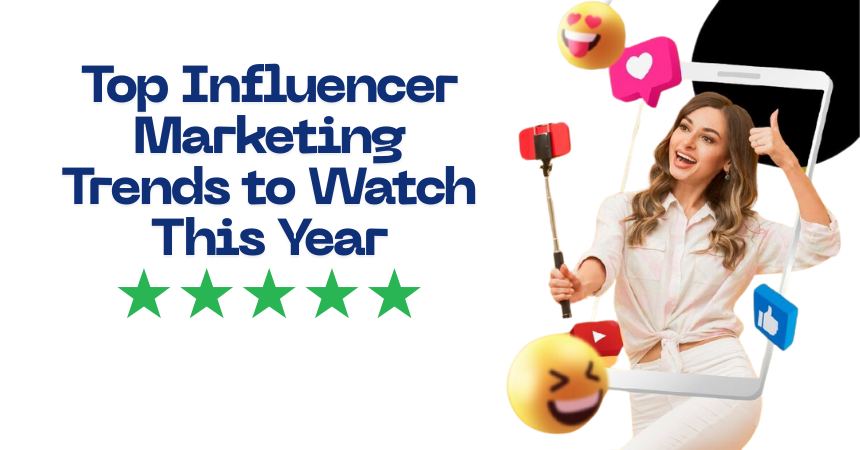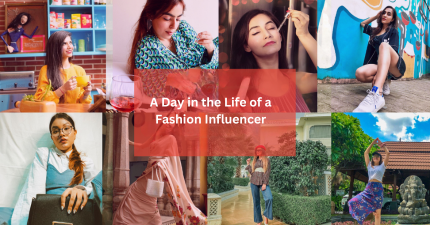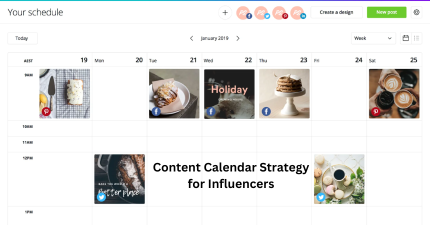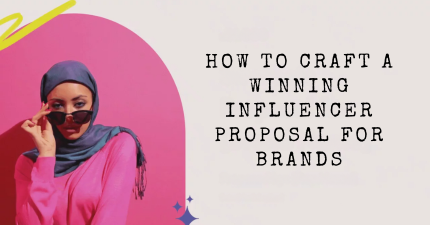
- 28 Oct, 2024
Unveiling the Future: Top Influencer Marketing Trends to Watch This Year
In a world where social media reigns supreme and consumer attention spans are shorter than ever, influencer marketing has emerged as a powerful force, transforming how brands connect with their audiences. But what’s next for this dynamic landscape? As we dive into 2023, it’s time to peel back the curtain and explore the trends that will shape the future of influencer marketing. This year promises to be nothing short of revolutionary, from innovative content formats to shifts in audience engagement strategies. Get ready to discover how these emerging trends can elevate your brand's presence and keep you ahead of the curve! Whether you’re a seasoned marketer or just dipping your toes into the influencer pool, buckle up—this is one journey you won’t want to miss!
Introduction to Influencer Marketing
Influencer marketing has transformed the way brands connect with their audiences. With social media platforms buzzing like never before, businesses are tapping into the power of influencers to reach potential customers in unique and authentic ways. As we dive deeper into 2021, it’s clear that this dynamic landscape is ever-evolving.
This year promises exciting changes that can reshape how companies strategize their marketing efforts. From micro-influencers making waves to a focus on authenticity, staying ahead means keeping an eye on emerging trends. The influence of trusted voices continues to grow as consumers seek genuine connections with brands they admire.
Let’s explore what lies ahead for influencer marketing and uncover the key trends shaping this vibrant industry!
Why is Influencer Marketing important?
Influencer marketing is crucial in today's digital landscape. It bridges the gap between brands and consumers, creating authentic connections.
Consumers are increasingly turning to social media for recommendations. They trust influencers who seem relatable and genuine, making influencer partnerships a powerful tool for brand visibility.
Moreover, traditional advertising methods often struggle to engage audiences effectively. Influencers offer an alternative that resonates more with potential customers. Their followers view them as credible sources of information.
The ability to reach targeted demographics is another advantage of influencer marketing. Brands can collaborate with niche influencers who speak directly to their desired audience segments.
Lastly, investing in influencer marketing drives engagement rates higher than conventional ads. This interaction fosters community building around brands, enhancing loyalty over time.
Top Influencer Marketing Trends of 2021
The world of influencer marketing is evolving at a rapid pace. This year, brands are shifting their focus toward micro-influencers. These creators often boast more engaged audiences and foster authentic connections that resonate with followers.
Authenticity and transparency have become non-negotiable for influencers. Consumers demand honesty in brand partnerships, guiding marketers to seek out genuine voices who align with their values.
Long-term relationships between brands and influencers are gaining traction. By investing time in these collaborations, companies can build trust over fleeting campaigns.
Diversifying platforms is key as well. While Instagram remains popular, TikTok and YouTube are rising stars where fresh content thrives.
Data-driven strategies offer insights into what works best for both the brand and influencer alike. Analyzing metrics helps refine approaches, maximizing impact while minimizing wasteful spending in a crowded market.
Rise of Micro-Influencers
The rise of micro-influencers marks a significant shift in the influencer marketing landscape. Brands are increasingly turning to individuals with smaller but highly engaged followings, typically ranging from 1,000 to 100,000 followers.
These influencers often boast more authentic connections with their audience. Their niche expertise allows for targeted campaigns that resonate deeply with specific demographics. This authenticity fosters trust, making audiences more receptive to brand messages.
Moreover, the cost-effectiveness of working with micro-influencers is appealing. They tend to charge less than mega or macro influencers while delivering impressive results due to their loyal fan base.
As consumers crave genuine interactions over polished advertising, micro-influencers bridge that gap beautifully. They create relatable content and foster community engagement in ways larger influencers might struggle to achieve.
Authenticity and Transparency
Authenticity and transparency have become vital in influencer marketing. Audiences today crave real connections. They can easily spot when someone is being disingenuous.
Influencers who share their honest experiences resonate more with followers. This fosters trust, which is essential for brand loyalty. When an influencer genuinely believes in a product, it shows.
Brands are now encouraging influencers to be open about partnerships. Disclosing sponsored content isn’t just ethical; it's expected. Consumers appreciate honesty and are more likely to engage with transparent campaigns.
The rise of social media has amplified this trend. Platforms like Instagram and TikTok thrive on relatable content that feels genuine. Influencers sharing behind-the-scenes glimpses or personal stories create stronger bonds with their audience.
As competition increases, authenticity sets brands apart in a crowded space. The most successful campaigns will embrace these values, leading the way for deeper consumer relationships.
Long-Term Partnerships
Brands are increasingly recognizing the value of long-term partnerships with influencers. Instead of one-off campaigns, the focus is shifting toward building lasting relationships. This approach fosters authenticity and trust among audiences.
When influencers work consistently with a brand, they become genuine advocates. Their followers notice this loyalty and often respond positively, enhancing engagement rates.
Long-term collaborations also allow for deeper storytelling. Influencers can share their experiences over time, creating a more immersive narrative that resonates with their audience.
Moreover, these partnerships lead to better alignment on messaging and goals. Brands can leverage an influencer's creativity while ensuring consistent representation across all platforms.
As both parties invest in each other’s growth, they can co-create content that reflects shared values and vision—resulting in stronger brand affinity among consumers who appreciate transparency and dedication.
Diversification of Platforms
As influencer marketing evolves, brands are no longer confined to traditional platforms. The rise of new social media channels has opened doors for innovative campaigns.
TikTok, Instagram Reels, and even emerging apps like Clubhouse provide fresh avenues for engagement. Each platform caters to unique demographics and content styles. Brands must adapt their strategies accordingly.
Video content is dominating the landscape, drawing users in with dynamic storytelling. Short-form videos offer quick bites that capture attention immediately.
Moreover, niche platforms are gaining traction as audiences seek specialized communities. This shift encourages brands to identify where their target audience spends time and how they interact on those platforms.
Diversifying across multiple channels allows companies not only to reach broader audiences but also to experiment creatively without relying solely on one medium. Embracing this trend could lead to unexpected success stories in influencer collaborations.
Data-Driven Strategies
Data-driven strategies are reshaping influencer marketing. Brands now rely on analytics to guide their choices, ensuring they connect with the right audience.
Understanding metrics like engagement rates and follower demographics can make all the difference. This knowledge allows marketers to select influencers whose values align with their brand message.
Using data also enhances campaign performance. By analyzing past campaigns, brands can identify what worked and what didn’t, allowing for constant improvement. A/B testing different approaches helps fine-tune messaging and creative content based on real-time feedback.
Moreover, predictive analytics is becoming essential in forecasting trends. With insights into consumer behavior patterns, brands can proactively adjust their strategies for maximum impact.
As competition intensifies, leveraging data will be vital for staying ahead of the curve in influencer marketing. It's not just about creativity anymore; it’s about making informed decisions that drive results.
Case Studies: Successful Influencer Campaigns in 2021
One standout campaign in 2021 was Gymshark’s collaboration with fitness influencers. By partnering with micro-influencers, they created authentic content that resonated deeply with their target audience. This approach not only showcased real-life transformations but also fostered community engagement.
Another notable success came from Daniel Wellington, a watch brand that leveraged an extensive network of influencers across various niches. Their strategy combined glamorous lifestyle posts with user-generated content on Instagram. This blend helped cultivate trust and expand their reach dramatically.
Dove’s #NoDigitalDistortion initiative focused on promoting body positivity through relatable influencer stories. It encouraged genuine conversations around self-esteem while reinforcing the brand's commitment to authenticity.
These examples illustrate how brands can harness the power of influencers effectively, connecting meaningfully with audiences and driving impressive results in today's digital landscape.
Challenges and Pitfalls in Influencer Marketing
Influencer marketing is not without its challenges. One significant issue lies in the prevalence of fake followers and engagement metrics. Brands can easily be misled by inflated numbers, leading to ineffective campaigns.
Another pitfall is market oversaturation. With so many influencers vying for attention, audiences may become desensitized to promotional content. This makes it harder for brands to stand out and engage effectively.
Additionally, the lack of regulations creates a murky landscape. Influencers often operate with little oversight, leading to inconsistencies in messaging and ethical concerns about transparency.
Navigating these obstacles requires vigilance from brands and marketers alike. Understanding these issues is crucial as they develop their influencer strategies moving forward.
Fake Followers and Engagement
Fake followers have become a significant concern in influencer marketing. Brands are often drawn to influencers boasting large follower counts, but these numbers can be misleading.
Many accounts inflate their following through purchased bots or fake profiles. As a result, engagement metrics may look impressive on the surface but lack authenticity. This creates a false sense of security for brands investing their budget based on inflated statistics.
Engagement rates tell another story. An influencer might have millions of followers yet receive minimal interaction on posts. Genuine connections lead to real conversions, making it essential to go beyond mere follower counts when evaluating potential partnerships.
Understanding this issue is crucial for marketers seeking meaningful relationships with consumers. Authenticity should always be prioritized over sheer numbers in every campaign strategy moving forward.
Oversaturation of the Market
The influencer marketing landscape is becoming crowded. Brands are eager to capitalize on the trend, leading to a surge in partnerships and collaborations.
As more influencers enter the scene, distinguishing oneself becomes increasingly challenging. Audiences face an overwhelming array of content, making it harder for any single campaign to stand out.
This oversaturation can dilute authenticity. Followers may grow skeptical about sponsored posts, questioning their sincerity and relevance. The original charm of influencer endorsements risks being overshadowed by repetitive promotions.
Brands must navigate this fine line carefully. They need to identify unique voices that resonate with their target audience while steering clear of the noise created by countless similar campaigns.
Ultimately, finding that sweet spot between visibility and genuine engagement will determine who succeeds in this ever-evolving marketplace.
- Lack of Regulations
The influencer marketing landscape is still relatively new, and with that comes a notable lack of regulations. This absence creates an environment where the rules are often ambiguous.
Brands may find it challenging to navigate ethical guidelines when partnering with influencers. Some influencers might not disclose sponsorships properly, leading to mistrust among their followers. Transparency is essential for maintaining credibility.
Additionally, without stricter regulations, there’s a risk of misleading advertising practices. Influencers could promote products they don't genuinely use or believe in simply for financial gain. This can harm both consumers and brands alike.
As the industry matures, it's crucial for stakeholders to advocate for clearer standards and best practices. Establishing these will help build trust and ensure that influencer marketing remains effective and sustainable moving forward.
Tips for Brands and Marketers to Maximize ROI in Influencer Marketing
To maximize ROI in influencer marketing, start with careful selection. Choose influencers whose values align with your brand. Authenticity resonates more than sheer numbers.
Establish clear objectives. Define what success looks like for each campaign—whether it’s engagement, brand awareness, or sales conversions.
Leverage micro-influencers as they often have higher engagement rates and a more loyal audience. They can provide niche reach that larger influencers may lack.
Invest in quality content creation. Collaborate closely with influencers to produce authentic and engaging material that reflects both their style and your message.
Measure and analyze performance consistently. Use analytics tools to track KPIs such as impressions, clicks, and conversions. This data will guide future campaigns effectively.
Encourage creativity by allowing influencers the freedom to express themselves while promoting your product naturally—a strategy that fosters genuine connections with their audience.
The Future of Influencer Marketing: Predictions for 2022 and Beyond
The landscape of influencer marketing is evolving rapidly. As brands seek deeper connections with audiences, expect a surge in niche influencers who cater to specific communities.
Artificial intelligence will play a crucial role. Brands might leverage AI tools for better analytics and targeting. This technology could streamline the selection process, ensuring partnerships align more closely with brand values.
Video content will dominate social media platforms. Short-form videos are becoming essential for engagement, prompting influencers to adapt their strategies accordingly.
Sustainability will also shape campaigns. Consumers increasingly prefer brands that reflect their values, including eco-friendliness and social responsibility. Influencers who embody these principles can drive authentic conversations around these topics.
Finally, regulations may tighten as scrutiny on transparency grows. Expect clearer guidelines governing sponsored content, pushing both brands and influencers toward greater accountability in their collaborations.
The Power
The landscape of influencer marketing is ever-evolving, bringing new opportunities and challenges to brands. As we have explored trends like the rise of micro-influencers and the emphasis on authenticity, it’s clear that understanding these shifts is crucial for success.
Brands must embrace data-driven strategies to maximize their ROI while navigating potential pitfalls such as fake followers or market oversaturation. The future promises even more growth in this field, with predictions pointing toward increased collaboration and diversification across platforms.
Harnessing the power of influencers can lead to genuine connections with audiences. By staying ahead of trends and focusing on meaningful partnerships, marketers can unlock tremendous potential in this dynamic marketing space.




